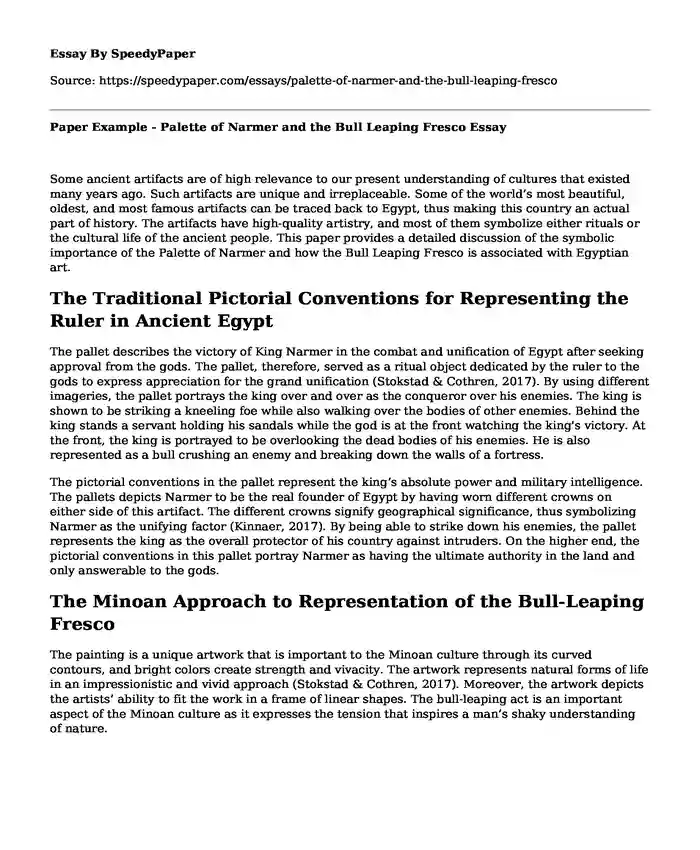Some ancient artifacts are of high relevance to our present understanding of cultures that existed many years ago. Such artifacts are unique and irreplaceable. Some of the world’s most beautiful, oldest, and most famous artifacts can be traced back to Egypt, thus making this country an actual part of history. The artifacts have high-quality artistry, and most of them symbolize either rituals or the cultural life of the ancient people. This paper provides a detailed discussion of the symbolic importance of the Palette of Narmer and how the Bull Leaping Fresco is associated with Egyptian art.
The Traditional Pictorial Conventions for Representing the Ruler in Ancient Egypt
The pallet describes the victory of King Narmer in the combat and unification of Egypt after seeking approval from the gods. The pallet, therefore, served as a ritual object dedicated by the ruler to the gods to express appreciation for the grand unification (Stokstad & Cothren, 2017). By using different imageries, the pallet portrays the king over and over as the conqueror over his enemies. The king is shown to be striking a kneeling foe while also walking over the bodies of other enemies. Behind the king stands a servant holding his sandals while the god is at the front watching the king's victory. At the front, the king is portrayed to be overlooking the dead bodies of his enemies. He is also represented as a bull crushing an enemy and breaking down the walls of a fortress.
The pictorial conventions in the pallet represent the king’s absolute power and military intelligence. The pallets depicts Narmer to be the real founder of Egypt by having worn different crowns on either side of this artifact. The different crowns signify geographical significance, thus symbolizing Narmer as the unifying factor (Kinnaer, 2017). By being able to strike down his enemies, the pallet represents the king as the overall protector of his country against intruders. On the higher end, the pictorial conventions in this pallet portray Narmer as having the ultimate authority in the land and only answerable to the gods.
The Minoan Approach to Representation of the Bull-Leaping Fresco
The painting is a unique artwork that is important to the Minoan culture through its curved contours, and bright colors create strength and vivacity. The artwork represents natural forms of life in an impressionistic and vivid approach (Stokstad & Cothren, 2017). Moreover, the artwork depicts the artists’ ability to fit the work in a frame of linear shapes. The bull-leaping act is an important aspect of the Minoan culture as it expresses the tension that inspires a man’s shaky understanding of nature.
How the Bull-Leaping Is Similar To Egyptian Art
The bull-leaping fresco is comparable to Egyptian artistic work in that it adopts a stylization of animals and people. There seems to be a close correlation between animals and humans in both Egyptian and Minoan artistic cultures (Buman, 2011). The leaping bull represents a realistic and naturalistic viewpoint, which is similar to Egyptian art that symbolizes real and natural happenings in people’s lives (Wolfe, 2015). Both the Minoan and Egyptian art are also characterized by filled in shapes with compact color and with no shading. Subject matter in both works have power symbols. The bull fresco symbolizes virility, strength, and fertility, while kings in Egyptian art symbolize authority.
How the Bull-Leaping Is Different From Egyptian Art
On the other hand, the leaping bull artwork is different from Egyptian art in that it is painted on a plaster and has a 2-dimensional texture. Contrary, most of Egyptian art was carved on limestone (Buman, 2011). The leaping bull does not have a puzzling array of viewpoints, and the artwork is represented solely. Alternatively, the Egyptian artwork appears to have a confusing array of views with many subjects clustered in a single stone.
References
Buman, S. (2011, October 19). Comparing Egyptian and Minoan works of art. Buman's Art History. https://b-humanarthistory.blogspot.com/2011/10/comparing-egyptian-and-minoan-works-of.html
Wolfe, J. (2015). Bull-leaping fresco (Ca. 1450-1400 BC). Furman University Scholar Exchange. https://scholarexchange.furman.edu/art231/36/Stokstad, M., Cothren, M. (2017, January 18. Art history. Pearson; 6 edition
Kinnaer, J. (2017, July 17). The Narmer Palette. The Ancient Egypt Site. https://www.ancient-egypt.org/history/early-dynastic-period/1st-dynasty/horus-narmer/narmer-artefacts/narmer-palette.html
Cite this page
Paper Example - Palette of Narmer and the Bull Leaping Fresco. (2023, Aug 23). Retrieved from https://speedypaper.com/essays/palette-of-narmer-and-the-bull-leaping-fresco
Request Removal
If you are the original author of this essay and no longer wish to have it published on the SpeedyPaper website, please click below to request its removal:
- Free Essay on Intercultural Communication Barriers and Solutions Between Nigeria and China
- Essay Example on Feminist Art in China and Britain
- Free Essay Sample: Financial Plan for Blessed Detergents Corporation
- Essay Sample on Aime Cesaire's A Tempest: The Mirror Up to Colonialism
- Free Essay in Americah History: Underground Rail Road
- Free Essay on Inequality in the Education Sector
- The Survey Method as the Primary Means of Data Collection. Essay Sample
Popular categories





